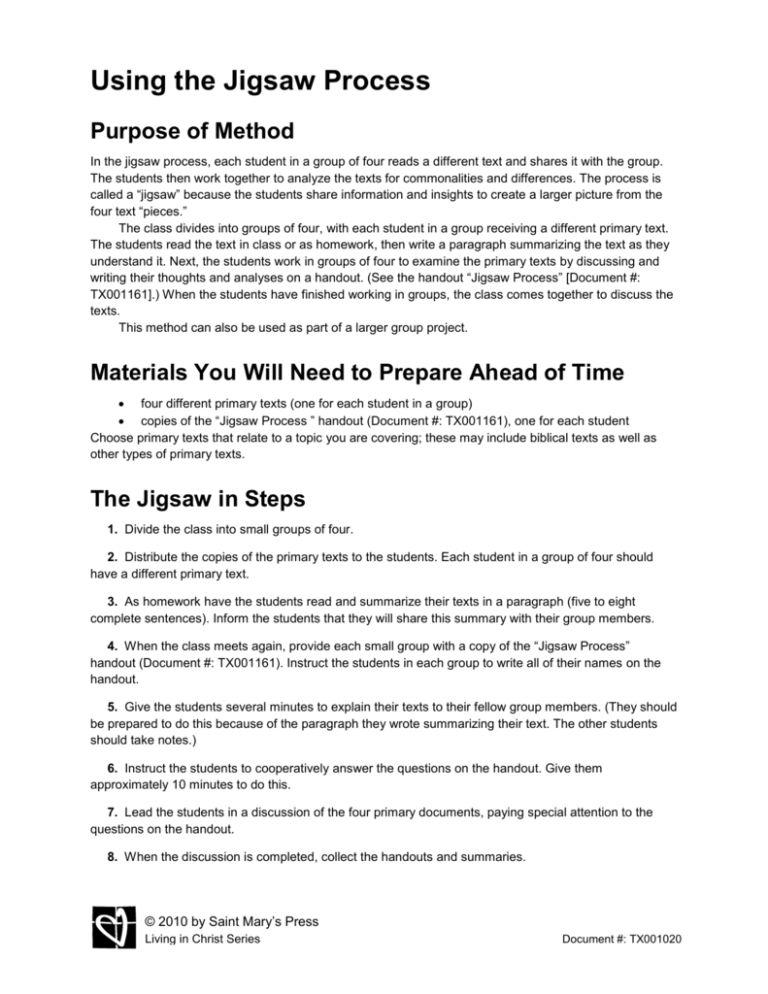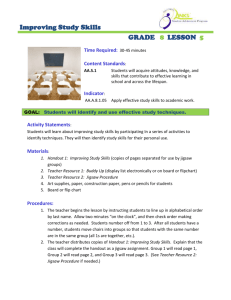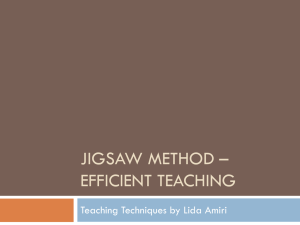Word - Saint Mary`s Press
advertisement

Using the Jigsaw Process Purpose of Method In the jigsaw process, each student in a group of four reads a different text and shares it with the group. The students then work together to analyze the texts for commonalities and differences. The process is called a “jigsaw” because the students share information and insights to create a larger picture from the four text “pieces.” The class divides into groups of four, with each student in a group receiving a different primary text. The students read the text in class or as homework, then write a paragraph summarizing the text as they understand it. Next, the students work in groups of four to examine the primary texts by discussing and writing their thoughts and analyses on a handout. (See the handout “Jigsaw Process” [Document #: TX001161].) When the students have finished working in groups, the class comes together to discuss the texts. This method can also be used as part of a larger group project. Materials You Will Need to Prepare Ahead of Time four different primary texts (one for each student in a group) copies of the “Jigsaw Process ” handout (Document #: TX001161), one for each student Choose primary texts that relate to a topic you are covering; these may include biblical texts as well as other types of primary texts. The Jigsaw in Steps 1. Divide the class into small groups of four. 2. Distribute the copies of the primary texts to the students. Each student in a group of four should have a different primary text. 3. As homework have the students read and summarize their texts in a paragraph (five to eight complete sentences). Inform the students that they will share this summary with their group members. 4. When the class meets again, provide each small group with a copy of the “Jigsaw Process” handout (Document #: TX001161). Instruct the students in each group to write all of their names on the handout. 5. Give the students several minutes to explain their texts to their fellow group members. (They should be prepared to do this because of the paragraph they wrote summarizing their text. The other students should take notes.) 6. Instruct the students to cooperatively answer the questions on the handout. Give them approximately 10 minutes to do this. 7. Lead the students in a discussion of the four primary documents, paying special attention to the questions on the handout. 8. When the discussion is completed, collect the handouts and summaries. © 2010 by Saint Mary’s Press Living in Christ Series Document #: TX001020 Using the Jigsaw Process Page | 2 Jigsaw Process 1. What topics does each of the four documents address? a. b. c. d. Document 1: Document 2: Document 3: Document 4: 2. What do the four documents have in common? a. b. c. d. 3. How are the four documents different? a. b. c. d. 4. If you had to create a title to unify these four documents, what would you choose? Why? a. Title: b. Reason: © 2010 by Saint Mary’s Press Living in Christ Series Document #: TX001020









